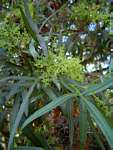4594.010 Searsia
RHUS L. p.p.
Moffett, R.O. (2007) Name changes in the Old World Rhus and recognition of Searsia (Anacardiaceae) Bothalia 37(2) 165-175
Description of the genus
Trees, shrubs or suffrutices. Leaves alternate, 3-foliolate. Panicles terminal, axillary or both. Flowers unisexual, rarely bisexual, very small (calyx segments usually less than 1 mm, petals usually less than 2 mm). Male flowers: calyx (4-)5(-6)-partite; petals (4-)5(-6), white, green or yellow; stamens 5; pistillode usually 0. Female flowers: calyx and petals similar to male; staminodes frequently present; ovary usually 1-locular. Styles 3. Fruit a spherical or ovoid and flattened drupe, frequently asymmetrical. Seeds ovoid or reniform, flattened. Derivation of name: after Paul B. Sears, 1891-1990, who was a renowned stratigraphic palaeontologist, ecologist and head of the Yale School of Botany Comment: Recent phylogenetic analyses of the Rhus complex using DNA and gene spacers have shown that the genus Searsia is clearly monophyletic and widely separated from Rhus sensu stricto. A further distinction is that Searsia is confined to the Old World (the Mediterranean, Africa and Asia) and Rhus sensu stricto is a New World genus. Worldwide: c. 110 species in the Old World, specifically the Mediterranean, Africa and Asia Zimbabwe: 3 cultivated taxa. Insects associated with this genus:
|
 |
Links to cultivated taxa View: living plant images - herbarium specimen images - all images for this genus
| Species | Content |
| lancea (L.f.) F.A. Barkley | Description, Image |
| natalensis (Bernh. ex C. Krauss) F.A. Barkley | Description, Image |
| pentheri (Zahlbr.) Moffett |
Other sources of information about Searsia:
External websites:
African Plants: A Photo Guide (Senckenberg): SearsiaBHL (Biodiversity Heritage Library): Searsia
EOL (Encyclopedia of Life): Searsia
GBIF (Global Biodiversity Information Facility): Searsia
Google: Web - Images - Scholar
iNaturalist: Searsia
IPNI (International Plant Names Index): Searsia
JSTOR Plant Science: Searsia
Mansfeld World Database of Agricultural and Horticultural Crops: Searsia
Plants of the World Online: Searsia
Tropicos: Searsia
Wikipedia: Searsia